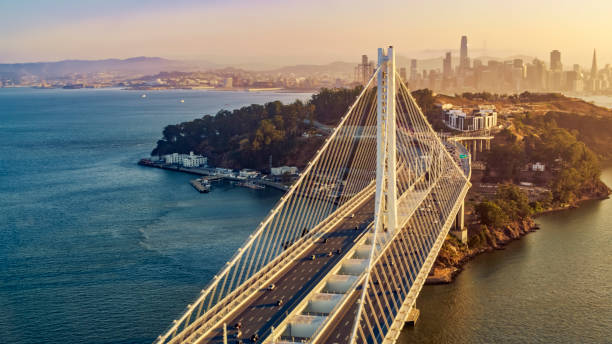In short, the traffic in Oakland flows better than in San Francisco; there are fewer cars during rush hours, public transportation is fast and near most neighborhoods, and bike lanes are safe and easy to use. But there are different things to consider when comparing the two cities.
Both San Francisco and Oakland have strong draws, but commuting changes depending on whether you drive, bike, or rely on mass transit. Let’s check some real data, neighborhood realities, and community opinions so you can decide where your commute might improve.
Average commute time in the Bay Area, SF, and Oakland
- Across the Bay Area, the average door-to-door commute now runs just over 32 minutes. People who drive alone average about 30 minutes one-way, while public-transit riders average much longer at roughly 51 minutes.
- San Francisco’s one-way commute has been clocked at around 30.9 minutes in recent analyses. Oakland’s average has declined versus pre-pandemic numbers, saving commuters an estimated ~4.5 minutes compared to 2019.
- BART now carries roughly ~180,000 weekday passenger trips based on recent reports, with tens of thousands squeezing through the Transbay Tube during peak hours.
What’s it like driving in San Francisco and Oakland?
If your commute is from Oakland to downtown San Francisco by car, you’ll cross the Bay Bridge (I-80). The Bay Bridge handles millions of vehicles per month, and weekday delays during peak windows are common.
If you live in outer neighborhoods like East Oakland or Fruitvale and commute to SoMa, you may save time by taking I-880 north to I-80, but congestion around the bridge toll plazas and the Embarcadero approaches can add unpredictable minutes.
Driving inside San Francisco is double-edged: short distances, like going from Hayes Valley to Civic Center, can be fast, but parking and slow streets mean many SF residents actually find driving more difficult than living in Oakland and driving in.
Moving tip: if you’re scheduling a move between Oakland and SF, book movers for mid-day or a weekend window; weekday bridge congestion and city parking enforcement make early morning or evening moves a headache.
Bay Area public transportation: BART, ferries, and the “last mile”
Since Oakland is near BART, it gets a few points for commuting. Neighborhoods like Uptown, Lake Merritt, Rockridge, and Jack London Square are close to BART stations that get you to Embarcadero, Montgomery, or Powell in 10–25 minutes, depending on express vs local trains.
BART is overall great, but it can also have surprises: there have been high-profile shutdowns and service interruptions that strand riders and force last-minute rideshare surges.
If you live in SF and work in SF, Muni/light-rail options exist, but many riders complain about some lines not being frequent enough, especially if your office is in the Financial District and you live in Bernal Heights or Outer Mission. Ferries are an attractive but expensive commuter option from Jack London or Alameda to the Ferry Building; excellent for comfort, not always for budget or schedule flexibility.
In short, BART is great when it works. But you might also find e-bikes and hybrid commutes (BART + bike) as a more reliable way of transportation.
What’s it like to use a bike in San Francisco and Oakland?
Both cities have invested in protected bike lanes. San Francisco in places like Dogpatch and The Embarcadero, Oakland in Temescal and Lake Merritt, making bike commutes easier for 20–40 minute trips. If your job is in the SOMA/SoMa/Financial District cluster, living in Potrero Hill or Dogpatch, and biking in can beat BART during rush hour. Also, Oakland’s flatter stretches (compared to SF’s hills) make e-bike commutes easier.
Moving note: when you move, make sure you’re prepared beforehand. Plus, consider packing your bike last and bringing it on the first day; a working bicycle can be your backup commute while you wait for setup and parking permits.
Where in San Francisco and Oakland will I have a better commute?
- If your priority is shortest door-to-desk time to downtown SF: live in Potrero Hill, South Beach, or Mission Bay (expensive, but walkable). These neighborhoods save minutes off Muni/BART transfers.
- If you want East Bay affordability with fast transit to SF: Rockridge, Uptown Oakland, and Jack London balance walkability with BART access.
- If you work in the Peninsula or South Bay: consider San Francisco neighborhoods near Caltrain (e.g., Mission Bay, SoMa). Oakland is more difficult for South Bay commutes.
- If you want driving and free parking: outer Oakland neighborhoods or farther-out East Bay suburbs offer savings, but you’ll trade time in traffic.
What else can make commuting worse in SF and Oakland?
Don’t forget non-commute factors that affect real-life commuting: childcare drop-offs (many parents build routes that avoid Transbay craziness), employer flexible hours (four-day or staggered schedules beat rush hour), and if there are coworking spaces near your home.
Keep in mind that a 9 a.m. office start vs 10 a.m. can change everything; shifting 60 minutes can make a BART+bike commute bearable rather than miserable.
Oakland vs. San Francisco real-world commute examples
- Oakland → Embarcadero (BART): Rockridge to Embarcadero — about 20–30 minutes including a short walk to the station.
- San Francisco local: Hayes Valley → Financial District by Muni — 25–35 minutes depending on transfer and wait times.
- Drive (Oakland → SF): 25–60+ minutes depending on bridge traffic and the time you leave.
These are averages; your mileage changes depending on address and date. Checking the Metropolitan Transportation Commission’s commute dashboards and monthly bridge counts can help you plan ahead.
San Francisco or Oakland: which one to choose for commuting?
- Choose Oakland if: you want lower rent than central SF, easy access to BART, and neighborhoods like Uptown or Rockridge that get you to SF quickly by rail. Oakland is often the better trade-off for transbay commuters who value space and relatively predictable BART travel times.
- Choose San Francisco if: you want the shortest in-city travel times to SF offices, value being within walking distance of work, or your job is in SoMa/Financial District and you want to avoid intercounty transit entirely.
If you’re still on the fence, try a three-week trial: commute from both places during peak hour, log door-to-desk time, and compare. (If you’re moving, note the best time to schedule movers while doing those trials. Weekday mid-day moves often help you avoid both rush hour and parking conflicts.)
Conclusion
When you put moving plans into motion, think about commute windows, parking rules for moving trucks in San Francisco, and BART station walking distances. Small things matter: a 10-minute walk to a smooth BART transfer can beat a 5-minute drive stuck in bridge backup.



